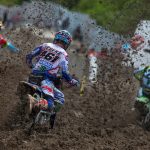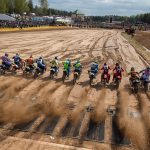It has been a lean season for KTM in MXGP and in the premier class that they became accustomed to owning for the better part of half a decade. MX2 yielded many more spoils but also a third year of injury-induced hand wringing. It could be argued that the Red Bull crew banked their most prized asset for three more years with the contract extension for Tony Cairoli in February that means the decorated Sicilian will almost certainly end his career in orange (and probably back on a 350SX-F). Despite his Swiss accomplishment last Sunday Cairoli has yet to silence a few critics and dispel a hint of scepticism that the new wave of intensity brought into the class by Romain Febvre and Tim Gajser – and no doubt other MX2 converts to follow – has blunted his potential to rule and win as before. Sport moves in cycles; there is little disputing the passage of time. However any kind of axe of opinion cannot hover too close to Tony until he admits that his pre-season injury woes and effects on his fitness have finally dispersed. We are talking about an athlete that knows no peer in the last ten years of international motocross when it comes to building, regenerating, saving and strategizing a championship campaign.
It was fascinating to speak with Monster Energy Kawasaki’s Clement Desalle recently; a rider that won MXGP Grands Prix every year from 2009-2014 and is the third winningest in the FIM World Championship in that period behind Cairoli and Herlings with nineteen triumphs. Now 26 years old and historically Cairoli’s closest challenger, the Belgian has fallen at the final hurdles too many times since 2012 due to injury. It was revealing to hear him ruminating on how Gajser and Febvre have cranked up the ‘limit’ in MXGP and how the pace is almost unsustainable. “As the years pass you get more experience…and let’s see how the future turns out because the young guys are very fast and pushing a lot and I think that will change,” he opined. “It is hard to live on the limit all the time without being injured.”
The irony is that Cairoli – who admitted to me on the eve of the 2015 season that he won his 2014 crown by riding at 70-80% – might have to discover a new boundary to reassert some authority and then find the same consistent ‘play’ (the same approach to a championship term of eighteen GPs and thirty-six motos that Desalle refers to) that led to so much success…at least for another three terms.
So, Cairoli gives KTM serious clout in MXGP and a clock must be ticking louder for Glenn Coldenhoff to find some groove with the 450SX-F in 2017 after an adaptation season (just his second in the division); after all Tommy Searle was ejected from Claudio De Carli’s line-up in 2015 for a lack of results. Glenn has been persistent but only just touched podium contention last weekend there will be riders looking at his saddle well before this time next year. The Italian combination of Cairoli-De Carli is the iron rod for KTM and will complete a decade of formidability but the news this week that Jeffrey Herlings will stay in Red Bull colours is like the spark to the welding torch.
Inevitably to the disappointment of Monster Energy and even HRC, Herlings took the expected route of remaining within an environment he has known since entering Grand Prix as a fifteen year old in 2010. The same KTM staff have laughed, endured, wept, frowned and basked in the ream of many highs and dramatic lows associated with the Dutchman’s tenure. The ‘family’ cliché applied to many descriptions of a rider’s symbiosis with a team is particularly apt in Herlings’ case, as he has moved through nodes of maturity and learning in the public eye and within a racing paddock (as opposed to a schoolyard, bar or sports field); teammate co-ordinator Valentina Ragni as the fretting and protective mother figure, MX2 Team Manager Dirk Gruebel as the occasionally disapproving but supporting paternal presence and brotherly back-up from the likes of Wayne, Rami and Ruben.
Herlings’ re-avowal with KTM is fundamental to the team and brand’s potency and exposure in Grand Prix motocross. Cairoli is the biggest name but Herlings is the Prince with one elbow on the armrest of the throne. I would argue that is it the most crucial contract that KTM Sport Director Pit Beirer has somehow created and inked since the German brought Cairoli to the company in 2010; after all, despite all the grand designs on MotoGP and even supercross, the European manufacturer has Grand Prix dirt under the fingernails. Herlings’ travails with injury are a distraction but don’t be fooled by the soap-operatic elements to ‘84’s story; Herlings is the type to continue that run of zest that younger riders are bringing into MXGP as Desalle suggested. Jeffrey has learned about the painful plummet on the other side of the ‘limit’ but his attacking prowess will continue to electrify MXGP for the next few years. I would also propose that his arrival carries the same if not more promise than that of Ryan Villopoto in 2015. Both athletes are (or were) in very different stages of their careers…and that’s without the use of hindsight.
KTM, thanks to Beirer, might have generated a level of organisation and competitiveness to entice and keep some of the top talent in the sport but the racing team collectively have felt how damn hard this sport can be (on both sides of the Atlantic). By pushing out the boat (can the shore still be seen? Will KTM budgets see reduced orange in the GP paddock?) with Herlings, KTM have not re-locked a ‘sure thing’ but they have guaranteed that they will continue to be most watched and most talked about presence in Grand Prix.
Photo by Ray Archer








